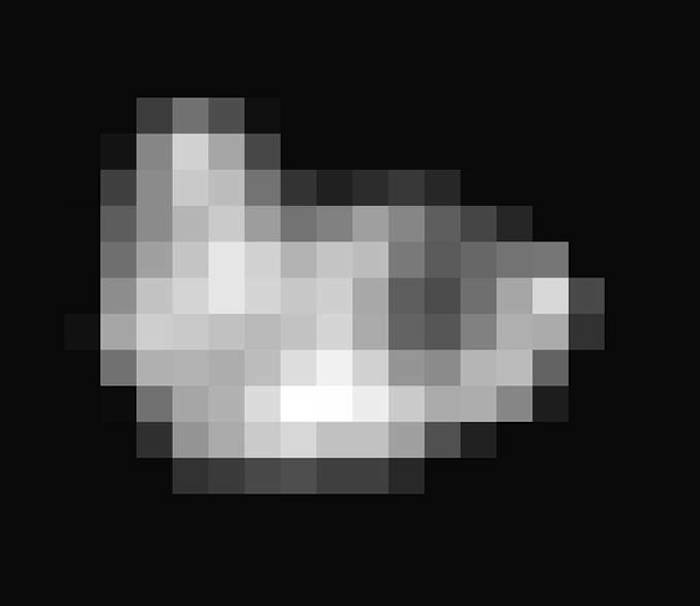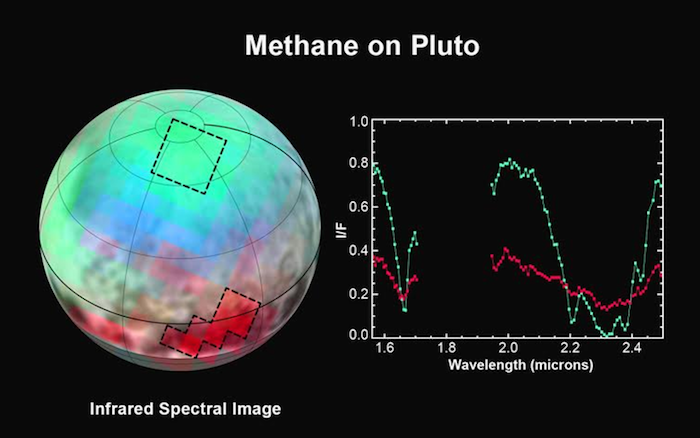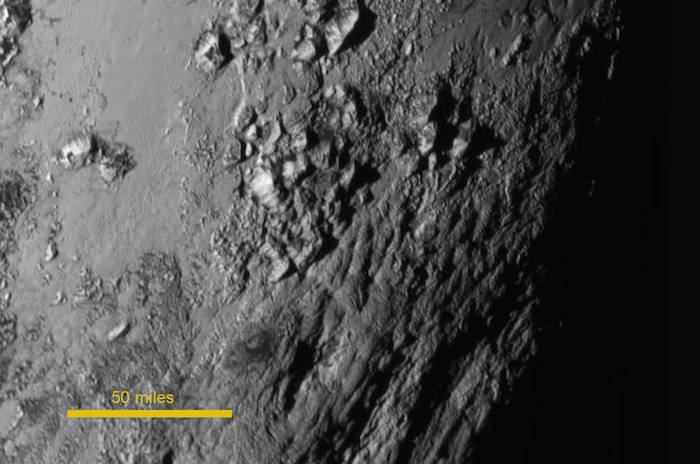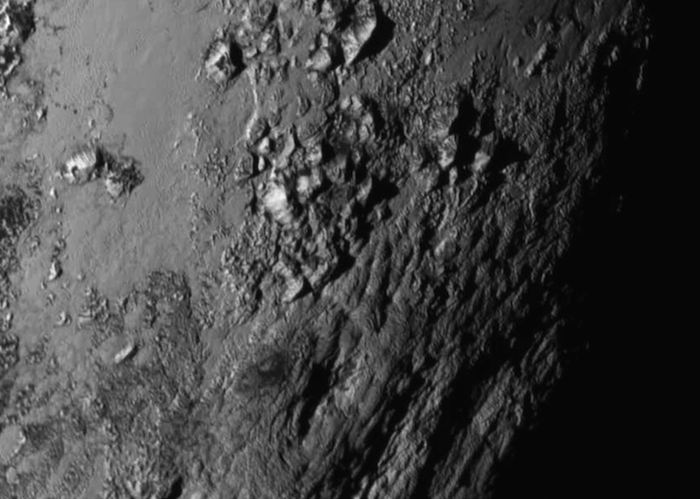The Icy Mountains of Pluto
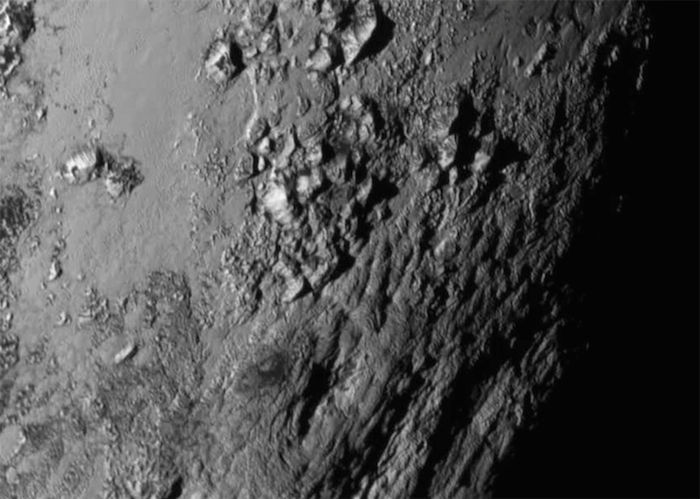
New close-up images of a region near Pluto’s equator reveal a giant surprise: a range of youthful mountains rising as high as 11,000 feet (3,500 meters) above the surface of the icy body.
The mountains likely formed no more than 100 million years ago -- mere youngsters relative to the 4.56-billion-year age of the solar system -- and may still be in the process of building, says Jeff Moore of New Horizons’ Geology, Geophysics and Imaging Team (GGI). That suggests the close-up region, which covers less than one percent of Pluto’s surface, may still be geologically active today.
Moore and his colleagues base the youthful age estimate on the lack of craters in this scene. Like the rest of Pluto, this region would presumably have been pummeled by space debris for billions of years and would have once been heavily cratered -- unless recent activity had given the region a facelift, erasing those pockmarks.
“This is one of the youngest surfaces we’ve ever seen in the solar system,” says Moore.
Unlike the icy moons of giant planets, Pluto cannot be heated by gravitational interactions with a much larger planetary body. Some other process must be generating the mountainous landscape.
“This may cause us to rethink what powers geological activity on many other icy worlds,” says GGI deputy team leader John Spencer of the Southwest Research Institute in Boulder, Colo.
The mountains are probably composed of Pluto’s water-ice “bedrock.”
Although methane and nitrogen ice covers much of the surface of Pluto, these materials are not strong enough to build the mountains. Instead, a stiffer material, most likely water-ice, created the peaks. “At Pluto’s temperatures, water-ice behaves more like rock,” said deputy GGI lead Bill McKinnon of Washington University, St. Louis.
The close-up image was taken about 1.5 hours before New Horizons closest approach to Pluto, when the craft was 478,000 miles (770,000 kilometers) from the surface of the planet. The image easily resolves structures smaller than a mile across.
Image Credit: NASA-JHUAPL-SwRI
.
New close-up images of a region near Pluto’s equator reveal a giant surprise -- a range of youthful mountains rising as high as 11,000 feet (3,500 meters) above the surface of the icy body.
Credits: NASA/JHU APL/SwRI
Icy mountains on Pluto and a new, crisp view of its largest moon, Charon, are among the several discoveries announced Wednesday by the NASA's New Horizons team, just one day after the spacecraft’s first ever Pluto flyby.
"Pluto New Horizons is a true mission of exploration showing us why basic scientific research is so important," said John Grunsfeld, associate administrator for NASA's Science Mission Directorate in Washington. "The mission has had nine years to build expectations about what we would see during closest approach to Pluto and Charon. Today, we get the first sampling of the scientific treasure collected during those critical moments, and I can tell you it dramatically surpasses those high expectations."
“Home run!” said Alan Stern, principal investigator for New Horizons at the Southwest Research Institute (SwRI) in Boulder, Colorado. “New Horizons is returning amazing results already. The data look absolutely gorgeous, and Pluto and Charon are just mind blowing."
A new close-up image of an equatorial region near the base of Pluto’s bright heart-shaped feature shows a mountain range with peaks jutting as high as 11,000 feet (3,500 meters) above the surface of the icy body.
The mountains on Pluto likely formed no more than 100 million years ago -- mere youngsters in a 4.56-billion-year-old solar system. This suggests the close-up region, which covers about one percent of Pluto’s surface, may still be geologically active today.
“This is one of the youngest surfaces we’ve ever seen in the solar system,” said Jeff Moore of the New Horizons Geology, Geophysics and Imaging Team (GGI) at NASA’s Ames Research Center in Moffett Field, California.
Unlike the icy moons of giant planets, Pluto cannot be heated by gravitational interactions with a much larger planetary body. Some other process must be generating the mountainous landscape.
“This may cause us to rethink what powers geological activity on many other icy worlds,” says GGI deputy team leader John Spencer at SwRI.
The new view of Charon reveals a youthful and varied terrain. Scientists are surprised by the apparent lack of craters. A swath of cliffs and troughs stretching about 600 miles (1,000 kilometers) suggests widespread fracturing of Charon’s crust, likely the result of internal geological processes. The image also shows a canyon estimated to be 4 to 6 miles (7 to 9 kilometers) deep. In Charon’s north polar region, the dark surface markings have a diffuse boundary, suggesting a thin deposit or stain on the surface.
New Horizons also observed the smaller members of the Pluto system, which includes four other moons: Nix, Hydra, Styx and Kerberos. A new sneak-peak image of Hydra is the first to reveal its apparent irregular shape and its size, estimated to be about 27 by 20 miles (43 by 33 kilometers).
The observations also indicate Hydra's surface is probably coated with water ice. Future images will reveal more clues about the formation of this and the other moon billions of years ago. Spectroscopic data from New Horizons’ Ralph instruments reveal an abundance of methane ice, but with striking differences among regions across the frozen surface of Pluto.
The Johns Hopkins University Applied Physics Laboratory in Laurel, Maryland designed, built and operates the New Horizons spacecraft and manages the mission for NASA’s Science Mission Directorate. SwRI leads the mission, science team, payload operations and encounter science planning. New Horizons is part of NASA’s New Frontiers Program, managed by the agency’s Marshall Space Flight Center in Huntsville, Alabama.
Quelle: NASA
-
Update: 16.07.2015
.
NASA to Release New Pluto Images, Science Findings at July 17 NASA TV Briefing
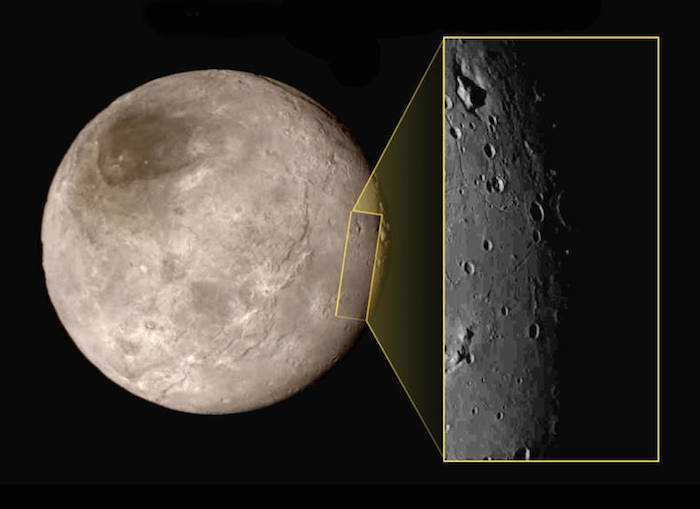
This new image of an area on Pluto's largest moon Charon has a captivating feature -- a depression with a peak in the middle, shown here in the upper left corner of the inset. The image shows an area approximately 240 miles (390 kilometers) from top to bottom, including few visible craters. The image was taken at approximately 6:30 a.m. EDT on July 14, 2015, about 1.5 hours before closest approach to Pluto, from a range of 49,000 miles (79,000 kilometers).
Credits: NASA-JHUAPL-SwRI
.
NASA will hold a media briefing at 1 p.m. EDT Friday, July 17, to reveal new images of Pluto and discuss new science findings from Tuesday’s historic flyby.
The briefing will be held in James E. Webb Auditorium at NASA Headquarters, located at 300 E St. SW in Washington. NASA Television and the agency's website will carry the briefing live.
Participants in the briefing will be:
Jim Green, director of Planetary Science at NASA Headquarters in Washington
Alan Stern, New Horizons principal investigator at Southwest Research Institute (SwRI) in Boulder, Colorado
Randy Gladstone, New Horizons co-investigator at SwRI in San Antonio
Jeffrey Moore, New Horizons co-investigator at NASA’s Ames Research Center in Moffett Field, California
Fran Bagenal, New Horizons co-investigator, University of Colorado, Boulder
Quelle: NASA
